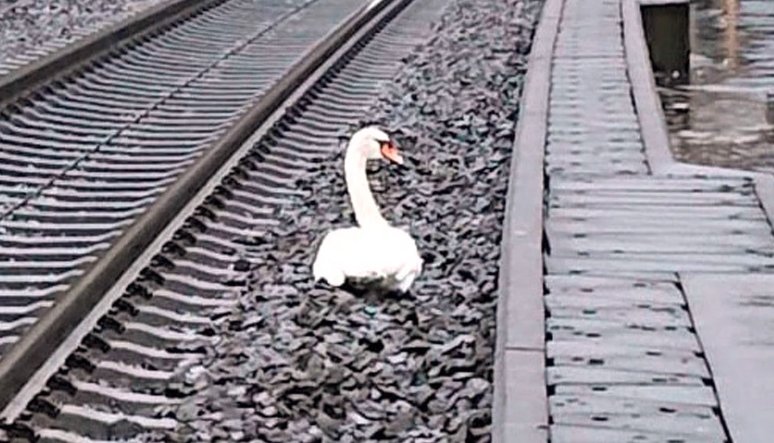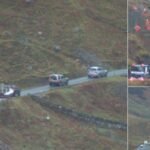A swan wandered onto the tracks at Glasgow Central Station in Scotland on October 27, 2025, causing major disruptions to evening rush hour train services. Hundreds of commuters faced delays and cancellations as rail operators worked to safely remove the bird from the busy high-level lines.
The Unexpected Visitor Hits the Tracks
The incident started around 5:49 p.m. local time when the swan appeared on the railway lines at Glasgow Central, Scotland’s busiest train station. This popular hub sees thousands of passengers daily, especially during peak hours, making the timing particularly challenging for travelers heading home.
Rail teams noticed the bird right away and slowed down trains to avoid any harm. The swan moved along the tracks for a while, dodging initial efforts to catch it. Reports from the scene described the animal as calm but persistent, turning what could have been a quick issue into an hour-long ordeal.

Widespread Impact on Commuters and Services
The swan’s presence led to at least 30 ScotRail services being canceled or delayed, stranding hundreds of passengers at the station. Other operators like Avanti West Coast and TransPennine Express also saw knock-on effects, with trains to places like London and Manchester running late or revised.
Commuters shared stories of frustration mixed with amusement on social media. Many waited over an hour for updates, while some had to find alternative transport options in the evening rush. The disruption rippled out, affecting routes across Scotland and beyond until late into the night.
To give a clear picture of the chaos, here is a timeline of key events:
| Time (Local) | Event Description |
|---|---|
| 5:49 p.m. | Swan spotted on high-level tracks at Glasgow Central. Trains slowed to reduced speeds. |
| 5:50 p.m. | Response team dispatched; first alerts sent to passengers about potential delays. |
| 6:00 p.m. | Photo of the swan shared publicly; services continue at low speed to protect the bird. |
| 6:20 p.m. | Swan safely removed from tracks; efforts begin to restore normal operations. |
| 9:42 p.m. | Full disruption ends; all services resume without further issues. |
This table shows how the situation unfolded step by step, highlighting the quick but careful handling by rail staff.
Network Rail Steps In to Save the Day
Network Rail Scotland acted fast by sending a dedicated response team to the site. They focused on retrieving the swan without injury, posting updates on social media to keep passengers informed. One update even called the bird the “culprit,” adding a light touch to the serious situation.
The team worked to guide the swan away from harm while keeping trains moving slowly. By around 6:20 p.m., they had successfully captured and relocated the animal to safety. Officials confirmed no one, including the swan, was hurt during the process.
Wildlife Woes on British Railways
This event is not unique in the UK, where animals often cause train disruptions. Swans rank high among common trespassers, with over 50 incidents reported in the past year alone.1
In recent months, similar cases have popped up across the country. For example, a swan built a nest on a busy line in September 2025, forcing temporary pauses in services until experts relocated it.2 Another incident in Hampshire back in March saw a swan lead to cancellations, reminding rail operators of the need for wildlife protocols.3
Experts point out that urban growth near waterways increases these encounters. Rail companies now train staff in animal handling and use barriers where possible. Still, each case requires on-the-spot decisions to balance safety for both wildlife and humans.
Here are some common animals causing rail issues in the UK:
- Deer: Over 300 incidents yearly, often in rural areas.
- Sheep: Around 170 cases, mainly in Scotland and Wales.
- Birds including swans: About 85 disruptions, with swans adding to the tally due to their protected status.
- Cows: Roughly 60 events, posing derailment risks if hit.
These figures underscore the ongoing challenge of sharing space with nature in a modern transport network.
Back to Normal After the Fowl Adventure
Services started picking up speed shortly after the swan’s removal, with full recovery by late evening. ScotRail thanked passengers for their patience and noted that the bird’s adventure had no lasting damage to the tracks or schedules.
The story brought smiles to many, with jokes about the swan’s “beak hour” circulating online. It also sparked talks about better wildlife management around stations near rivers like the Clyde. As rail travel grows in Scotland, such reminders highlight the blend of urban life and nature.
If you faced delays from this or have tips on handling animal encounters, share your thoughts in the comments below. Like and share this article to spread the word about unexpected travel tales.


















